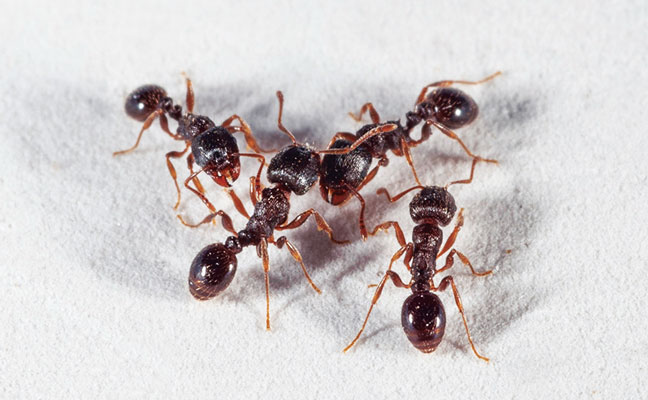
Pavement ants are about 1/8-inch long, with characteristic ridges running the length of their head. PHOTO: JOHN OBERMEYER, PURDUE UNIVERSITY
Tetramorium caespitum are widely known to engage in massive, drawn-out battles in territorial disputes. They are found to nest in areas with minimal vegetation, which explains their predisposition to urban habitat and why they thrive in human-modified environments. It is currently unclear as to where the ants nest exactly in or around structures, or if they damage them. However, their common name — pavement ants — is derived from their tendency to nest around foundations, sidewalks, driveways, and other man-made structures that interface with the soil.
Territorial disputes happen often in pavement ants, so it is implied that territoriality is a very important aspect of the biology and ecology of the species. Territoriality might be looked at in terms of nest area or areas being foraged. Although some ant species do not necessarily defend territories, there are many ant species that do, including pavement ants. Studying them as they forage above-ground is a useful research tool.
Pavement ants are social insects. The queen relies on workers to find and bring food into the colony to share via trophallaxis (grooming) among themselves, the queen, and the brood. Previous studies have determined that when using bait to control ants, the bait’s active ingredient should have delayed action over a wide dosage range, be readily transferred from one ant to another, and not be repellent to the ants.
Treatment methods
Nine residential buildings on the Purdue University campus and nine residential buildings in an apartment complex in West Lafayette, Ind., were used to evaluate the effectiveness of a 0.01 percent thiamethoxam insecticide gel bait. Each building was divided equally among three treatment categories: target, blanket, and untreated control. Each building used in this study was divided into twenty 17-foot-long “territorial units” — based on the smallest pavement ant colony found (as determined by aggression assays, where the lack of aggression defined the borders of each colony).
For targeted treatments, one colony per building was randomly selected for treatment and received 2 grams of bait per “territorial unit” that the colony included. Thus, a colony spread out over three “territorial units” would receive 6 grams of bait.
For the blanket treatment, all colonies around each of these buildings would receive 2 grams of bait for each “territorial unit” they occupied. Finally, untreated buildings received no bait applications.
Findings

Epic battles between pavement ant colonies leave piles of dead worker ants on a sidewalk. PHOTO: JOHN OBERMEYER, PURDUE UNIVERSITY
While the blanket treatment showed initial reduction in pavement ant numbers, and targeted ant treatment showed initial increases in pavement ant numbers, there was no statistical difference between the two treatments. Both treatments resulted in low ant numbers by one month after treatment.
Our study findings suggest the decision to perform the blanket or targeted treatment comes down to two factors:
- How widespread is the pavement ant infestation?
- How quickly does the customer want to see results?
In an account where an ant problem is extensive, for example, blanket baiting as an initial treatment may be followed by target baiting (on an as-needed basis) to provide favorable customer satisfaction.
Other findings include:
- Given the aggressive nature of pavement ants, we believe that in many situations, larger colonies would be more prevalent, especially as warm summer weather progresses.
- Competition for food resources was noted, as has been found in other studies, to be mostly between pavement ant colonies. Large numbers of dead pavement ants are found after pavement ant battles.
- Focusing the bait treatment near the nest entrances (or away for the colony boundaries and close to the center of a colony’s territory) is more efficient. When bait is placed near the territorial boundary, pavement ants from neighboring colonies spend more time fighting than accessing the bait. Thus, placing the bait near the center of the colony should improve bait efficiency.
Understanding pavement ant behavior, foraging ecology, and population dynamics is certainly useful in managing this pest ant. The findings of this study should assist pest management professionals in developing effective pavement ant management programs regardless of geographic location.
Plentiful pavement ants
An interesting finding in our study was how serious a pavement ant problem can be in some parts of the U.S. As they relate to the “territorial units” (based on the smallest colony size we found in the two areas of West Lafayette, Ind.), which were of the smaller territorial/colony size:
- Sixty colonies consisted of one territorial unit.
- Forty colonies were of two territorial units.
- Seventeen colonies consisted of three territorial units.
- Four colonies were four units.
- Two colonies were five units.
The post Purdue study fine-tunes baiting for pavement ants appeared first on Pest Management Professional.
from Pest Management Professional https://www.mypmp.net/2019/06/11/purdue-study-fine-tunes-baiting-for-pavement-ants/
Sacramento CA
The Orkin Man is trained to help manage Pavement Ants and similar pests.Since every building or home is different, your Orkin technician will design a unique program for your situation.The Orkin Man can provide the right solution to keep Pavement Ants in their place out of your home or business.exopest
ReplyDelete